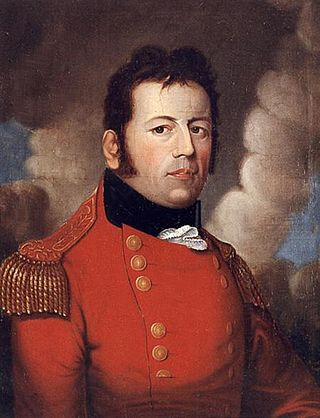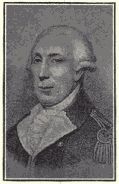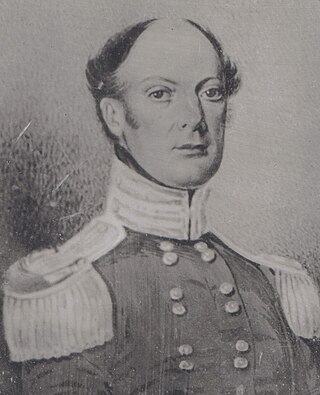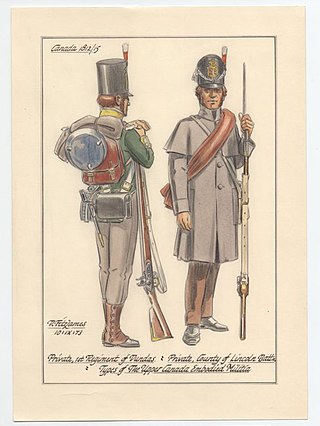
John Graves Simcoe was a British Army general and the first lieutenant governor of Upper Canada from 1791 until 1796 in southern Ontario and the watersheds of Georgian Bay and Lake Superior. He founded York, which is now known as Toronto, and was instrumental in introducing institutions such as courts of law, trial by jury, English common law, and freehold land tenure, and also in the abolition of slavery in Canada.


Guy Carleton, 1st Baron Dorchester, known between 1776 and 1786 as Sir Guy Carleton, was a British Army officer, peer and colonial administrator. He twice served as Governor of the Province of Quebec, from 1768 to 1778, concurrently serving as Governor General of British North America in that time, and again from 1785 to 1795. The title Baron Dorchester was created on 21 August 1786.

Sir George Prevost, 1st Baronet was a British Army officer and colonial administrator who is most well known as the "Defender of Canada" during the War of 1812. Born in New Jersey, the eldest son of Genevan Augustine Prévost, he joined the British Army as a youth and became a captain in 1784. Prevost served in the West Indies during the French Revolutionary Wars and the Napoleonic Wars, and was commander of St. Vincent from 1794 to 1796. He became Lieutenant-Governor of Saint Lucia from 1798 to 1802 and Governor of Dominica from 1802 to 1805. He is best known to history for serving as both the civilian Governor General and the military Commander in Chief in British North America during the War of 1812 between Britain and the United States.

Brigadier-General Sir John Johnson, 2nd Baronet was an American-born military officer, magistrate, landowner in the British Indian Department who fought as a Loyalist during the American Revolutionary War. He was the son of Sir William Johnson, 1st Baronet, who was the first British Superintendent of Indian Affairs. He inherited his father's baronetcy and estate in 1774.

The King's Royal Regiment of New York, also known as Johnson's Royal Regiment of New York, King's Royal Regiment, King's Royal Yorkers, and Royal Greens, were one of the first Loyalist regiments, raised on June 19, 1776, in British Canada, during the American Revolutionary War.
Christopher Alexander Hagerman, was a Canadian militia officer, lawyer, administrator, politician and judge.
Captain John McDonell of Aberchalder was a soldier, judge, and political figure in Upper Canada following the American Revolution. He was elected as the first speaker for the Legislative Assembly of Upper Canada.
Thomas Fraser was a soldier and political figure in Upper Canada.
The Hon. Richard Cartwright was a businessman, judge and political figure in Upper Canada.

John Munro, was generally referred to as 'Captain The Hon. John Munro of Fowlis' to distinguish him from others with the same name and rank. He was a Highland soldier who after the Seven Years' War received extensive land grants at Albany, New York, becoming a prominent Tory and merchant associated with Simon McTavish and the fur trade. Having gained a reputation for no-nonsense, he was made a magistrate and given further land at Vermont to bring Ethan Allen and the Green Mountain Boys to order. Ever the ardent Loyalist, Munro fought for the British during the American Revolutionary War which led to the loss of his land following the American victory. He re-settled in Upper Canada, where he became a Judge and was appointed to the first Legislative Council of Upper Canada.

Colonel The Hon. Philip VanKoughnet M.P., landowner, businessman and political figure in Upper Canada.

James Macaulay M.D., J.P. was the Chief Medical Officer of Upper Canada; a landowner and Justice of the Peace for York, Upper Canada.
John Crysler was a businessman and political figure in Upper Canada.

Peter Shaver was a farmer, businessman and political figure in Upper Canada.
George Stephen Benjamin Jarvis was a judge and political figure in Upper Canada.

George Brouse was a farmer, businessperson, and political figure in Upper Canada.

Richard Duncan Fraser was a fur trader, businessman, farmer and political figure in Upper Canada.

The Queen's Rangers, also known as the Queen's American Rangers, and later Simcoe's Rangers, were a Loyalist military unit of the American Revolutionary War. Formed in 1776, they were named for Queen Charlotte, consort of George III. The Queen's Rangers was a light corps in the tradition of British rangers during the Seven Years' War, operating on the flanks and in advance of Crown forces, manning outposts, conducting patrols, and carrying out reconnaissance and raiding operations.

The Dundas County Militia was a regiment of the provincial militia of Upper Canada that was raised in Dundas County, Ontario, in the 1780s. The battle honours and legacy of the Dundas Militia are perpetuated by the Stormont, Dundas and Glengarry Highlanders.